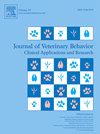Obsessive compulsive/compulsive disorder in companion animals: An ethological approach
Abstract
Abnormal repetitive behaviors are complex and varied, likely originating from both environmental and genetic factors. Diagnostic criteria emphasize behaviors that are in excess of that required to accomplish what would be any functional goal of the class of behavior, for example, non-functional acts and behaviors that interfere with the patient’s ability to engage in normal social behavior or to avoid pain or risk. There is a lack of consensus on when and how a repetitive behavior can be considered a pathological condition, that is, obsessive-compulsive/compulsive disorder (CD/OCD). This diagnosis is now frequently used in veterinary medicine to characterize ritualistic and repetitive behaviors that are excessive compared to what is necessary for proper function and without interference with daily functioning. The present study was aimed at revealing specific ethological patterns involved in CD/OCD in order to help clinicians early recognize signs of CD/OCD and thus target therapeutic interventions. We found that compulsive disorders present a specific motor structure compared to their corresponding ordinary actions. According to our results, not only repetition (repeated actions) and frequency (the rate at which actions occur over a particular period of time) but also redundancy (superfluous actions that are non-functional for the achievement of a goal) of behaviors should be considered as key feature in CD/OCD in companion animals.

 求助内容:
求助内容: 应助结果提醒方式:
应助结果提醒方式:


